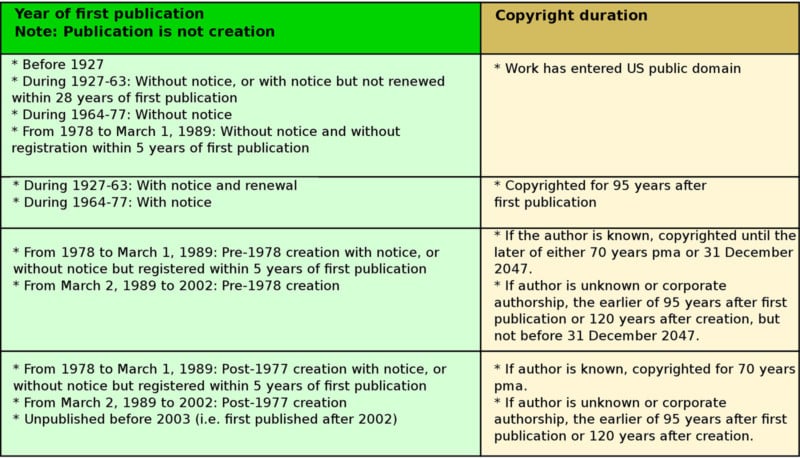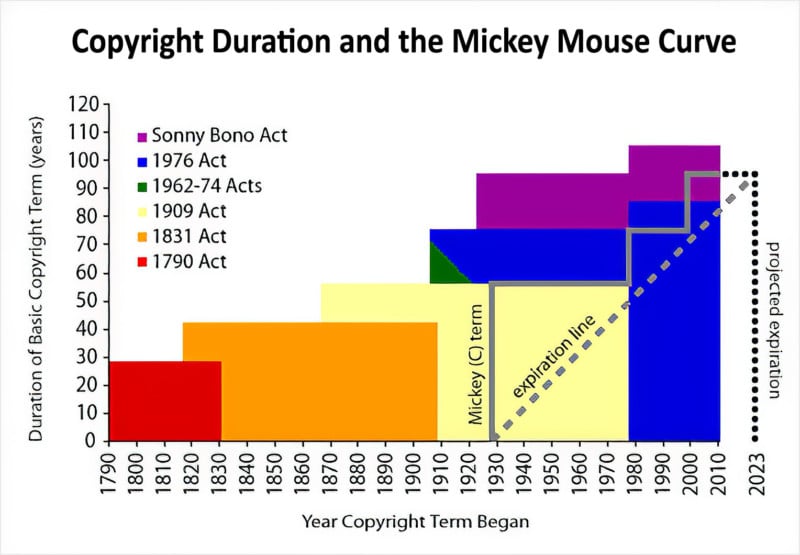How Long Does Copyright Last?
![]()
Rights management is vital to photographers and other creatives who want to zealously protect the copyright of the images they capture. How long a person can legally prevent anyone from profiting from their intellectual property can be confusing, as the provisions of copyright have changed many times over the years.
Copyright Term Depends on Several Factors
According to the US Copyright Office, how long a copyright lasts depends on several factors, chief of which is when a creative work has been published.
“The term of copyright for a particular work depends on several factors, including whether it has been published, and, if so, the date of first publication,” states the US Copyright office website.
The office goes on to expand on this by stating that if the work was published after January 1, 1978, the term of copyright shall be limited to the life of the copyright holder, plus 70 years.
When it comes to work created anonymously, under a pseudonym, or made for hire, the copyright duration is 95 years from the date it was first published or 120 years from when it was created, whichever expiration date arrives first.
For content published before 1978, the previous Copyright Act of 1909 protected work for a period of 28 years, though an additional 28-year extension could be granted. If the extension was not applied for, then the copyrighted work would permanently slip into the public domain with no additional copyright protection. There is one exception to this, and that’s due to the provisions of the Uruguay Round Agreements Act (URAA), where certain foreign works whose U.S. copyright protection had been lost because of noncompliance could be restored as of January 1, 1996.
However, the Federal Copyright Act of 1976 extended the length of the renewal term increased to 47 years. Congress amended the law in 1992, to add an automatic renewal provision, so copyright holders couldn’t lose their protection should they forget to apply for renewal. There was also an interim Copyright Extension act of 1998, which further pushed the copyright protection by another 20 years to 67 years. There were at least nine other copyright revisions passed by Congress between 1909 and 2002, to cover other intellectual works during set periods of time that wouldn’t fall under the provisions discussed here.
Here is a handy table that breaks down the copyright duration of a work depending on when it was first published.

The relevant information for most people reading this article is this: living photographers and creatives creating work under their own name in the present day will own copyright protection for 70 years after their death.
Mickey Mouse and Ever-Changing Copyright Law
Sounds confusing? Well, it is. Why would there be so many copyright revisions in federal law over the last 100 years? The answer is … Mickey Mouse. No, that doesn’t mean it’s a flimsy explanation. It means literally that Mickey Mouse is the reason why copyright protection continues to be extended every couple of decades.
The Walt Disney Company has successfully managed to lobby Congress and the Federal Copyright office to extend the useful date of copyright protection to the life of the author plus 120 years in order to prevent Mickey Mouse and other Walt Disney properties from slipping into the public domain. Walt Disney, the copyright holder of Mickey Mouse died 55 years ago, in 1966.

With a multi-billion dollar trademark (and that’s an entirely different set of requirements), it’s easy to see why the publicly held Walt Disney Company which has carried on in his memory, would want to protect his works for as long as possible. All good things must come to an end, however, and unless Disney manages to convince Congress to act once more to extend the term of copyright protection, Mickey Mouse will lapse into the Public Domain effective January 1, 2024.
But even then, Disney has a measure of protection. For starters, only Mickey Mouse as depicted in the film Steamboat Willie will move into the public domain. As each depiction of Mickey on film has changed, the copyright period for each work is independent. So just because Steamboat Willie isn’t protected doesn’t mean that The Sorcerer’s Apprentice isn’t. That version of Mickey won’t expire until 2036.
Then there’s the issue of Mickey Mouse as a trademark, which has its own terms and time periods, complicating the matter even further. According to The Disney Food Blog’s citing of a professor at NOVA South Eastern University, “Trademark law protects words, phrases, and symbols used to identify the source of the products or services. Copyright protects works of artistic expression from being copied.”
Again, it’s confusing. Other countries also have their own separate copyright provisions, making matters even more complicated.
The information contained in this article is provided for informational purposes only and should not be construed as legal advice on any subject matter. To determine where work falls under these various copyright legalities, it’s best to talk to a copyright attorney or visit the U.S. Copyright Office Website. There’s also a comprehensive circular, known as Circular 15a, that summarizes the provisions of each copyright act, which is available for download and study.
Image credits: Header illustration created with images from Depositphotos